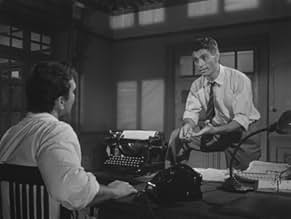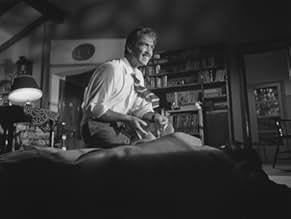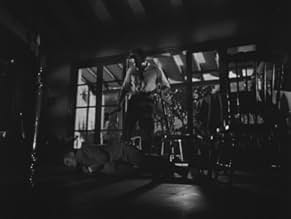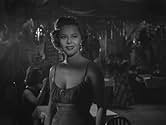Ajouter une intrigue dans votre langueA washed up reporter teams up with an immigrant from Hungary to start a fake journalism by correspondence school.A washed up reporter teams up with an immigrant from Hungary to start a fake journalism by correspondence school.A washed up reporter teams up with an immigrant from Hungary to start a fake journalism by correspondence school.
- Director
- Writers
- Stars
- Prix
- 2 victoires au total
Otto Webber
- Noriega
- (as Otto Weber)
George Hilton
- Hombre en redacción
- (as Jorge Hilton)
Avis en vedette
I've always searched great but unknown films noirs from outside USA, in England of course, but also France, Italy, Scandinavia, Egypt, South America and especially Argentina.
I just discovered this Argentinian noir movie, and it's a must. A real tough brainstorming in music, cinematography, script, acting. A constant crescendo creepy atmosphere about a man possessed by nasty war II nightmares. Very intelligent use of music by Astor Piazolla , wonderful cinematography by Ricardo Younis (Gregg Tolland's student). And what an ending, never seen such a cynical one. Bravo.
I just discovered this Argentinian noir movie, and it's a must. A real tough brainstorming in music, cinematography, script, acting. A constant crescendo creepy atmosphere about a man possessed by nasty war II nightmares. Very intelligent use of music by Astor Piazolla , wonderful cinematography by Ricardo Younis (Gregg Tolland's student). And what an ending, never seen such a cynical one. Bravo.
Based on this 1956 offering I'd say the Argentines have a thorough grasp of noir, no? This dark, curdled tale of not good vs evil but rather amiable crookedness vs evil is utterly fascinating. It's not a case of whom to root for but rather which of the two antagionists do we pity less? Tough call. On the one hand you have the loud, unctuous con artist and on the other there's the tortured, psychotic worm. My sympathies ultimately came down on the side of the later, but it was a close call and was made all the closer by the skilled performances of the two lead actors, Carlos Cores and Vassili Lambrinos, who perfectly embody these twin poles of ethical and moral corruption in mid 50s Argentina, as the tyrannical Peronist era was yielding to a slightly less tyrannical succession of military strongmen, an uneasy time in a country haunted by a repressive and fascistic past and facing an uncertain future. This state of mind is subtly brought out by director Fernando Ayala and his scenarist Sergio Leonardo in such scenes as the nightmares of Gaspar as he confronts his father's Nazi past and the wonderfully ironic ending where a hopeful new generation is planting flowers from bitter stems, unknowingly atop a corpse's grave. Throw in bleak, shadowy cinematography from one of Greg Toland's more apt pupils, Ricardo Younis, and a seductive jazz/tango score by Astor Piazzola and one can see why this film is a near masterpiece. Why near? Didn't like the character of Jarvis who is, in my opinion, unbelievably credulous around an obviously nutso Gaspar. Give it an A minus.
I am glad i found out about this movie. This is not a hidden gem but it's a good, maybe very good, crime/drama-film noir and every fan of this genre will probably like it. It doesn't even need to be a big fan of this genre, because all the elements of a good movie are here. Very good actors, a clever script, a very good director, nice cinematography and overall, an interesting-at least- movie.
I can't say i understood well the whole thing about this fraudulent operation of them. Maybe it was lost in translation. But the movie doesn't depend on this either way. Probably the biggest quality here is the script, this movie works better as a character study. The protagonist is a veey interesting character. And if you pay attention to his motives and his whole psyche, everything that he does is explainable. Not justified of course, but viewer can see the reasons.
It's getting gradually better and the last 20-30 minutes are the best part of this movie. I loved the fact that i couldn't see where it goes even though old movies are usually great but mostly predictable. The ending was very powerful if you catch the symbolisms. I didn't but i read some reviews and i understood this movie better.
I can't say i understood well the whole thing about this fraudulent operation of them. Maybe it was lost in translation. But the movie doesn't depend on this either way. Probably the biggest quality here is the script, this movie works better as a character study. The protagonist is a veey interesting character. And if you pay attention to his motives and his whole psyche, everything that he does is explainable. Not justified of course, but viewer can see the reasons.
It's getting gradually better and the last 20-30 minutes are the best part of this movie. I loved the fact that i couldn't see where it goes even though old movies are usually great but mostly predictable. The ending was very powerful if you catch the symbolisms. I didn't but i read some reviews and i understood this movie better.
"Los tallos amargos" is a great example of film noir released out of USA. Following the tradition of classic Hollywood (the most brillant time in the history of cinema), this picture tell us the story of a poor journalist who, trying to make easy money, begins to work with an hungarian inmigrant. They start a fake journalism school and soon their pockets are full of dirty money. When the journalist begins to have suspects on your partner, the plot will become most than interesting. A perfect movie, a very good story. A picture that looks like any american film of that time. 9 out of 10.
EXTRA: When the A.F.I. chose the 100 bests cinematography of all time, this argentine movie was in the list among titles like "Citizen Kane" (!)
EXTRA: When the A.F.I. chose the 100 bests cinematography of all time, this argentine movie was in the list among titles like "Citizen Kane" (!)
Very dated movie done --part of it-- as expressionistic 1930s German cinema, part as realistic 1950s European neo realism, all mixed up with a very Argentinian way of interpreting the brief and blunt dialogs throughout the whole movie.
The story is quite interesting. It could have been superbly interesting if the script could have been fully developed going deeply into the main character psychology and motives for his behavior instead of the bumpy way shown here so abruptly from one scene to the next (unless I saw a faulty copy with missing scenes).
Our tortured main character motivations for what he does, as seen in this version, is totally incomprehensible, since he has no real proof to take such a drastic measure to solve the dilemma that tortures his feverish mind.
The photography may be the best asset in this film, done in black and white with a very impressive atmosphere, dark and oppressive almost all the time.
The soundtrack is also very good, following the black mood of the story very precisely and to the point.
But the whole feeling disclosed here, either about the city, its people or our protagonists is nowadays as removed from us as a Christopher Columbus ship could be as incongruous standing next to an atomic submarine.
The story is quite interesting. It could have been superbly interesting if the script could have been fully developed going deeply into the main character psychology and motives for his behavior instead of the bumpy way shown here so abruptly from one scene to the next (unless I saw a faulty copy with missing scenes).
Our tortured main character motivations for what he does, as seen in this version, is totally incomprehensible, since he has no real proof to take such a drastic measure to solve the dilemma that tortures his feverish mind.
The photography may be the best asset in this film, done in black and white with a very impressive atmosphere, dark and oppressive almost all the time.
The soundtrack is also very good, following the black mood of the story very precisely and to the point.
But the whole feeling disclosed here, either about the city, its people or our protagonists is nowadays as removed from us as a Christopher Columbus ship could be as incongruous standing next to an atomic submarine.
Le saviez-vous
- AnecdotesAs discussed on TCM's Noir Alley by host Eddie Muller in July 2021, a screening of the restored 35mm print of this film was held on behalf of the Film Noir Foundation at the Museum of Modern Art (MoMA) in New York City in February 2016, and shockingly in attendance was 90 year-old Vassili Lambrinos, who, after years of living in various parts of the globe, was living just a few blocks from MoMA. Lambrinos had never seen the film on the big screen nor with an audience before that screening, having seen the film only in an editing room before then.
- Citations
Andreani: You make him infallible. You have an old passion; the need to obey.
Alfredo Gaspar: Passion to obey?
Andreani: To be a subordinate.
- ConnexionsReferenced in Preserving Memory: Fernando Martín Peña on Argentine Cinema (2024)
Meilleurs choix
Connectez-vous pour évaluer et surveiller les recommandations personnalisées
- What is the running time of this film ?
Détails
- Date de sortie
- Pays d’origine
- Langue
- Aussi connu sous le nom de
- The Bitter Stems
- Lieux de tournage
- Plaza de Mayo, Buenos Aires, Argentine(Gasper and Jarvis walk in the Plaza de Mayo and look at the Cabildo.)
- société de production
- Consultez plus de crédits d'entreprise sur IMDbPro
- Durée1 heure 30 minutes
- Couleur
- Mixage
- Rapport de forme
- 1.37 : 1
Contribuer à cette page
Suggérer une modification ou ajouter du contenu manquant





























